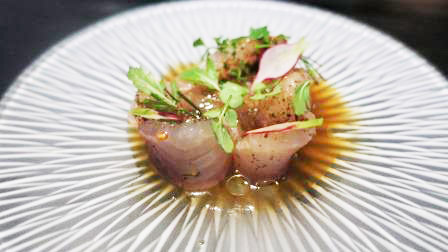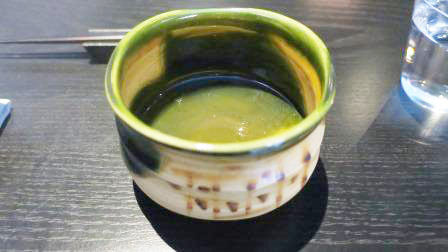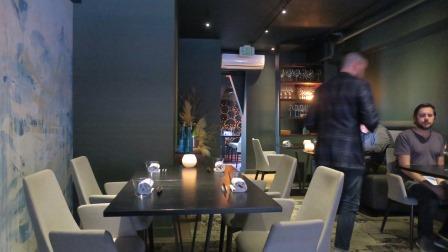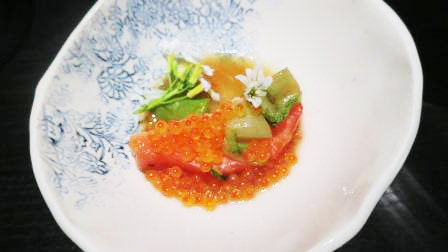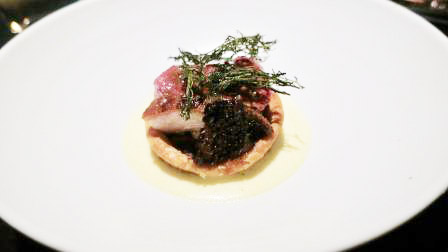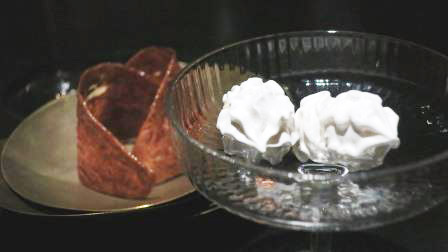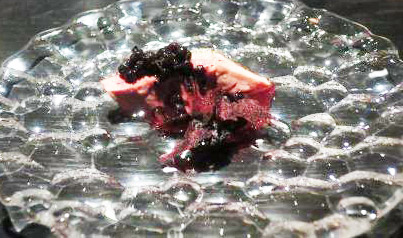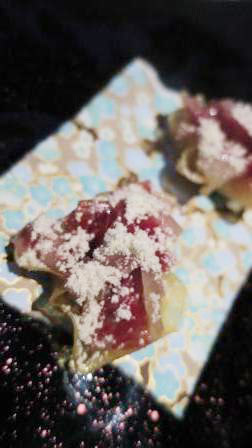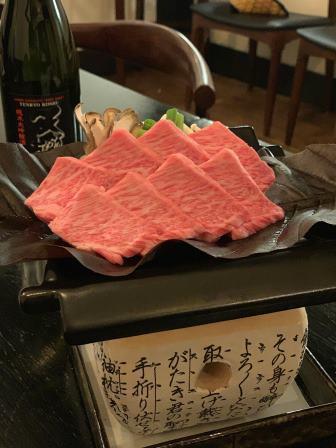Hashtag "#sake" returned 294 results.

By Yuji Matsumoto
Sake is a beverage of preference. However, “delicious” sake all have common universal traits.
The flavors can be characterized as follows:
-Sweetness
-Acidity
-Saltiness
-Bitterness
-Umami
In terms of food preparation, the common factor that creates a “delicious” taste for consumers is the balance between these flavors. “Preference” refers to this balance being achieved first, followed by one’s preferred flavor, such as ‘sweetness,’ being slightly stronger than the other four characteristics.
The same can be said about sake. Sake flavors are evaluated based on how well-balanced these flavors (saltiness mostly does not exist in sake) are. With sake, sweetness and acidity are easily detected with the first sip. However, “umami” flavor is an underlying taste, mostly detected as an aftertaste or when passing the tongue.
Some curious brands of (low-rated) sake have unbalanced flavors, where one flavor is strongly notable while lacking another.
Those who prefer dry, but well-balanced sake might enjoy the acidity upon swallowing the sake, while enjoying the short aftertaste that lingers on the palate; while those who prefer sweet flavors may likely enjoy sake with a fruity note and a mellow flavor with a long-lasting finish.
The most important training is to determine your own axis of flavors, best accomplished by enjoying a wide range of sake, and enjoying the same brand of sake over a period of time.
�好みの酒を見つける
酒は嗜好品、しかし“美味しい”ものには普遍的な共通のものがある。
味覚を分析すると;
・甘味
・酸味
・塩味
・苦味
・旨味
ということになる。料理において、人が“美味しい”と感じる共通の要素はこのバランスにある。“好み”と言われるのは、このバランスがあった上で甘いものが好きな人は“甘味”が他の4味覚より若干強いものを美味しく感じるのである。
日本酒も同じでこれらの味覚(塩味はほとんどない)がいかにバランスよく配分されているかが評価どころである。比較的甘味と酸味は、飲んだ瞬間にアタックしてくるので分かりやすい。しかし、旨味は密かに潜んでおり、後味や舌に通過する時に感じやすい。
ちょっと気になる(評価の低い)酒は、一つの味覚部分が突出していたり、欠けていたりすることで味がちぐはぐになっていることである。
バランスがあった上で辛口が好きな人は、おそらく飲んだ瞬間の酸の立っている、短い余韻の酒を好むだろうし、甘党の人は果実系の香りがあり、まったりとした長い余韻の酒を好むであろう。
一番大切なトレーニングは、自分の味の軸を確立することである。それには、多種類の酒を飲むより、同じ酒をじっくりとある程度の期間飲む方が早道である。
�
尋覓喜好的酒
酒是滿足個人喜好的飲料;但「美味」的酒都有一些普遍的共通點。
如以味道分析:
- 甜味
- 酸味
- 鹹味
- 苦味
- 甘味
則分為以上幾類。在烹飪中,人們感到「美味」的共同要素存在於此一平衡中。在此平衡上,喜歡甜食的人若能嚐到「甜味」比其他四種味道略為濃烈,就會感到「美味」;此謂「喜好」。
而清酒亦然。此等味道(幾乎沒有鹹味)的平衡分布的優劣正是其評價點。相對其他味道,酸味和甜味會在品嚐的瞬間刺激味蕾,故易於分別。然而,甘味會潛藏在內,在餘味中或經過舌頭時容易感覺之。
比較令人在意(低評價)的酒,是其中一種味道突出或欠缺,而導致味道欠缺調和的酒。
喜歡干型(Dry)的人應該會更喜歡在喝的瞬間酸味突出而餘韻短暫的酒;嗜甜的人應該會更喜歡有水果香味,以及餘韻持久的酒。
最重要的訓練是建立個人的品味。而達成以上事情的捷徑,莫過於花費一段時間仔細品嚐相同的酒;比同一時間品嚐各式各樣的酒更為有效。
�기호에 맞는 술 찾기
술은 기호품이지만 "맛있는" 것에는 보편적인 공통점이 있습니다.
미각을 분석하면 다음과 같습니다.
- 단맛
- 신맛
- 짠맛
- 쓴맛
- 감칠맛
사람이 음식을 "맛있다"라고 느낄 때의 공통점은 이들이 균형을 이룬다는 것입니다. "기호"라는 것은 이들이 먼저 균형을 이룬 후에, 단맛을 좋아하는 사람은 "단맛"이 다른 네 가지 미각보다 약간 강할 때 맛있게 느끼는 것입니다.
니혼슈도 마찬가지인데, 이러한 미각(짠맛은 거의 없음)이 얼마나 균형 있게 배분되어 있는지가 평가 요소가 됩니다. 단맛과 신맛은 마시자마자 느껴지기 때문에 비교적 알아차리기 쉽습니다. 그러나 감칠맛은 살짝 숨어있다가 뒷맛과 혀를 통과할 때 느껴집니다.
다소 우려되는 (낮게 평가되는) 술은 하나의 미각 부분이 지나치게 부각되거나 결여되어 있어 맛 자체가 어우러지지 않습니다.
균형감이 있는 상태에서 쌉쌀한 맛의 술을 좋아하는 사람은 아마도 마시는 순간 신맛이 느껴지는 짧은 여운의 술을 선호할 것이고, 달콤한 술을 좋아하는 사람은 과일향이 나며 부드럽고 감칠맛 나는 여운이 길게 남는 술을 좋아할 것입니다.
가장 중요한 훈련은 자신만의 맛의 축을 확립하는 것입니다. 그렇게 하려면 여러 종류의 술을 마시는 것보다 어느 정도의 기간을 두고 차분하게 마시는 것이 빠른 방법입니다.

By Mayumi Schroeder / Photo: Elli Sekine
“Avery” is a new rising star among the high-end restaurants in San Francisco, which opened last year on Fillmore Street, where many select shops and popular restaurants stand. This restaurant was featured in the San Francisco Chronicle, Eater Magazine, etc., and has been talked about a lot. The owner/chef, Rodney Wages (34) has a background in French cuisine, but does not have any experience in working or being trained at Japanese restaurants. He says the place offers an American-style izakaya menu. It sounds like izakaya means “a-la-carte” to him. The interior of the restaurant is sophisticated and black color-based, and there is no sign outside. Opening the front door leads you to an elegant, chic, and high-class atmosphere.
Rodney learned the basics of French cuisine at Le Cordon Bleu, Minneapolis, and in 2004, he encountered Cory Lee, who was the Executive Chef of “French Laundry”, a Michelin 3-starred restaurant at that time. Then, he worked there as an intern, and started to show his talent as a chef. 4 years later, he worked in Korea with Mr. Lee. In 2010, he joined the launch of Mr. Lee’s restaurant, “Benu”, which is presently Michelin 3-starred. After that, he has worked as a sous chef at a few Michelin-starred restaurants such as “Morimoto Napa”, “Saison”, and “Atelier Crenn”. “RTB”, which was a pop-up restaurant launched by Mr. Wages in 2017, was a big success, and gave him the big boost to open “Avery” later.
At “Avery”, a modern and sophisticated course menu showcases not only the knowledge and techniques Rodney has accumulated, but also his cooking philosophy which is built in. “I wanted to create an American course menu in which Asian food ingredients are used, and served not with chopsticks, but a knife and a fork like a western style menu,” says Rodney. In this restaurant, pairing is done only with Japanese sake and champagne. Their sake sommelier is Daniel Bromberg, who has a broad knowledge of Japanese culture and sake, and has worked for “True Sake” and “Les Clos”, and is a powerful contributor for their sake selection.
The dashi used for Avery’s course menu contains kombu and katsuobushi, which gives some depth to the umami of its dishes. The sauce has been completed by combining flavors of French, Japanese, and Korean cuisines harmoniously, and its delicate yet rich taste also gives a depth to the dishes. The food ingredients come from farmer’s markets, and also some well-known contracted farms in the suburbs.
This time, I got to taste 11 dishes of the “Chef’s Omakase Course” ($130). To pair with sake, you pay $89, and with champagne, $189 more, respectively. Among them, the following dishes took my breath away when I saw them delivered to the table; “Dashi mariné of sashimi-style fish and vegetables”, which consists of 3 kinds of fish, shima-aji, horse mackerel, etc., which has been aged for a week, and soaked in salt, and then their aroma enhanced by Bincho-charcoal grilling, and “Oyster Berry”, which is Iberico ham perfectly matched with pureed sunchoke, served in a cup made out of dried sunchoke. As for “Goose egg and Oyster lips”, a neatly emptied eggshell is used as the container of the egg yolk and dashi mixed with butter broth, in which you can enjoy crispness and creaminess at the same time.
“Aebleskiver”, a popular dish from the RTB period, is also included in the course. I couldn’t help but smile about its clever presentation when I saw it. The dish was Dungeness crab meat wrapped in Danish pancake, and it was brought to the table on a palm of a monkey figurine. Another nice dish was “Roasted duck”. A locally grown duck from the Sonoma area was aged for several weeks before roasted, and the rich fatty duck was flavored with cognac and balsamic vinegar. The topping was blueberries, which gave a good balance to the entire taste of this dish.
It was an excellent sophisticated course, and I fully enjoyed the delicate and artistic presentation of each dish.
For pairing, aside from the Saga prefecture’s junmai-ginjo, “Tembuki”, and Junmai-ginjo, “Miyasakae”, there were kinds which were clean and a good match to rich food, such as “Midorikawa”, on the sweet side, Yamaguchi prefecture’s “Dassai 50”, “Yamahai Junmai-ginjoshu, Jijoshu”, etc., which ultimately enhanced the dishes.
“This is just the beginning. I anticipate acquiring a Michelin star in the future,” Rodney told me, as his aspiration. I can feel the coming of more high-end Japanese courses in the future.
ハイエンドのコース料理に最高の酒ペアリング
セレクトショップや人気レストランが数多く立ち並ぶサンフランシスコ市のフィルモアストリートに去年オープンしたハイエンドレストランの新星、「Avery」。サンフランシスコ・クロニクル紙やEater 誌などに掲載された話題のレストランだ。“ アメリカン居酒屋メニュー”というオーナーシェフのロドニー・ウェイジス氏(34)は日本食レストランでの修行経験がないフレンチ出身のシェフ。居酒屋というのは彼の中で「一品」を意味しているようだ。同店は黒を基調とした洗練されたインテリアで、外には看板がなく、中に入るとモダンでスタイリッシュな内装が広がっている。
ル・コルドン・ブルーのミネアポリス校でフレンチの基礎を学び、2004 年にミシュラン3 つ星の「French Laundry」で当時エグゼクティブシェフを務めていたコーリー・リー氏と出会う。その後、インターンシップとして同レストランに勤務しシェフとしての頭角を現していった。4 年後には韓国でリー氏のスーシェフを務めた。2010 年に、現在ミシュラン3つ星を持つリー氏のレストラン「Benu」の立ち上げチームに加わった。
その後も「Morimoto Napa」や「Saison」、「Atelier Crenn」のミシュラン星レストランでスー・シェフを務めている。その彼が2017 年に手掛けたポップアップレストラン「RTB」が大ヒット、これが「Avery」をオープンする大きなキッカケとなった。
「Avery」ではロドニーが今まで培ってきた知識や技術だけでなく、彼の料理哲学を盛り込んだモダンで洗練されたコースメニューを提供している。「箸を使わずに西洋風にナイフやフォークを使って食べる、アジア食材を使ったアメリカンのコース料理を作りたかった」とロドニー。同レストランでのペアリングは日本酒とシャンペンのみ。酒ソムリエは、日本文化や豊富な日本酒の知識を持ち「True Sake」や「Les Clos」での経歴を持つダニエル・ブロムバーグ氏で、酒選びの頼もしい味方だ。
「Avery」のコース料理に使用される出汁には昆布や鰹節が使用されており、料理の旨味に奥深さを与えている。ソースはフレンチや日本食、韓国料理を調和した味わいに仕上げられ、繊細だが濃厚な味付けが料理に深みを加えている。食材はファーマーズマーケットや郊外の某有名農家と取引している。
今回は「シェフお任せコース($130)」から11 品を賞味させて頂いた。(酒ペアリングは$89、シャンペンのペアリングは$189 が追加料金となる)その中でもシマアジやホースマカレルなど3 種類の魚を1 週間熟成させた後に塩で締め、備長炭で香りを出した「刺身風の魚と野菜の出汁マリネ」や、イベリコハムと菊芋のピューレクリームの相性が抜群の「オイスターベリー」が菊芋を乾燥させたカップで運ばれて来た時にはその美しさに目を惹かれた。同様に綺麗にくり抜かれた鴨の卵の殻を器として使用し、黄身と出汁&バターのブロスで和えた「鴨の卵とオイスターリップス」はクリスピーからクリーミーな食感を一度に楽しめる一品。
RTB 時代の人気メニュー「Ableskiver」もコースに組み込まれ、デニッシュ風パンケーキにダンジェネスクラブのクリームが入った料理がサルの置物の手の平に乗って運ばれて来た時はその演出に思わず笑みが浮かんだ。他にもソノマの地元産鴨を3 ~ 4 週間かけて熟成された「ローストダック」は、脂がのった味わい深い鴨をコニャックやバルサミコ酢で味付けし、トッピングのブルーベリーとアレンジする事で味のバランスを整えている。全ての料理の繊細で芸術的なプレゼンテーションに堪能する事が出来た洗練されたコースだった。
またペアリングには「佐賀県の純米吟醸“ 天吹”」や「純米吟醸“Miyasakae”」の他に、クリーンな飲み口でリッチな食事との相性が良い「緑川」、甘口系の「山口県の“獺祭50”」や「山廃純米吟醸酒 時醸酒」などで、料理を最高に引き立た。
「この店はまだ最初の1 歩だが、将来はミシュラン星も想定している」と意気込みを語るロドニー氏。今後の更なるハイエンドなコース料理と酒ペアリングの進化を期待したい。
Avery
1552 Fillmore Street
San Francisco, CA 94115
(415) 817-1187
Website: www.AverySF.com
Social Media: @avery_sf
Wed.-Sun. 5:30pm-9:30pm

By Kosuke Kuji
Nambubijin is the first sake brand in the world to satisfy the Jewish dietary requirement by acquiring “Kosher” certification in 2013.
Thanks to this Kosher certification, the sales route for Japanese sake overseas is gradually changing from the conventional channels known for Japanese restaurants and grocery chains.
Needless to say, it is common knowledge among Japanese sake brewers and anyone remotely familiar with sake for that matter that sake is brewed without using any animal products.
Why not emphasize this “common knowledge” more? I was advised by an American mentor that “the most precious values are common sense values,” thus I recognized receiving third party certification for these “commonly known” values will expand the possibility of widespread consumption for Japanese sake.
Therefore, I went ahead and acquired the first ‘vegan’ certification for Japanese sake in both Japan and worldwide to encourage the consumption of Japanese sake among vegan consumers.
Our certification was acquired from the Japan Vegan Society domestically, and from The Vegan Society overseas.
Currently, ‘delicious’ flavor is also the expected standard in the wine industry, with priority given to “safety, reliability, and natural” products as key terms, along with “Non GMO” wine and “BIO” certified wine selections emerging in the market.
Currently, Japanese sake is consumed overseas paired with Japanese cuisine among foreign nationals who are familiar with and friendly towards Japan. That in itself is wonderful, and I’m grateful for our foreign consumers of Japanese sake.
However, looking ahead 20 and 30 years into the future, acquiring ‘vegan’ certification for Japanese sake, “commonly known” to contain no animal products of any kind, will lead to new opportunities for market development.
Therefore, I’d like to encourage more sake breweries acquiring these certifications in the near future to help establish an impression that “Japanese sake is vegan, therefore safe, reliable, and natural” worldwide.
「世界初!ヴィーガン認定の日本酒」
南部美人では、2013年にユダヤ教の食餌規定である「コーシャ」の認定を取得しました。
このコーシャの認定をきかっけに、海外での日本酒の販売ルートが、従来の日本食レストランや日本食スーパーから少しずつ変化をしてきました。
そんな中で、日本酒は動物性の物質を一切使わずに仕込みをしていることは、私たち蔵元はもちろん、少し日本酒を知っている人ならば誰でもわかる常識です。
その「当たり前」をなぜもっと言わないのか、もっと言うと「その当たり前に尊い価値があるのだ」とアメリカの恩人からアドバイスをされ、その「当たり前」をしっかりと第三者に認定してもらう事で、さらに日本酒の可能性が広がると感じ、この度、完全菜食主義者の方々が食べられる、飲むことが出来る認定「ヴィーガン」を日本、そして海外で世界で初めて認定していただきました。
日本国内は日本ヴィーガン協会、海外はThe Vegan Societyでの認定となります。
今、ワインの世界でも「おいしい」は当たり前で、その先に「安心・安全・自然」がキーワードとなっていて「NON GMO」のワインや、「BIO」認定のワインなどもたくさん出てきています。
日本酒もまだまだ日本食と日本を好きな外国人が飲んでいる状況ですが、それはそれでとてもありがたい事ですが、この先20年、30年先の未来に向けて、日本酒の「当たり前」である動物性の物質を一切使わず仕込んでいる事を「ヴィーガン」の認定として受ける事で、新たな市場開拓に繋がります。
この先、多くの蔵元がヴィーガン認定を取ることで、「日本酒はヴィーガンだから安心・安全・自然」というイメージを世界で定着させていきたいと思います

I’m often asked by Americans, “I often use wine for cooking, but can I also use Japanese sake?” Japanese sake contains many umami flavors not found in wine, so it’s great that they can be used in anything.
Eliminating odors
Of course, sake is not only effective in eliminating odors from fish and seafood, but also from pork and lamb. Of course the odor dictates lamb meat, however, when adding Japanese flavor to your cooking, add Japanese sake to any food when the odor is too strong, then leave it for approximately two minutes for the odor to disappear.
Effective in softening proteins
Placing chicken breasts, red beef, and / or meat for stew in a zip lock bag filled with sake prior to marinating eliminates the dryness from the meat and adds flavor. Sake greatly enhances the flavor of meat for barbeque and yakiniku.
Adds umami flavor
From broiled dishes to soup dishes, Japanese sake is useful in a variety of dishes, as our readers know. Surprisingly, Japanese sake also enhances the flavors of Western soup, especially in seafood, along with pasta and various other dishes. Please give it a try. Actually, sake is also great when used even in instant ramen noodles!
Japanese sake is great for cooking
Sake for cooking or Junmai sake is great for food preparation. While Ginjo and Daiginjo are great for drinking, Junmai is better suited and more effective for cooking due to it’s higher concentration of umami flavors.
日本酒と料理
よくアメリカ人から聞かれるのが、「ワインは料理に使うけど日本酒も使えるのか?」ということだ。日本酒には、ワインにない旨み成分がたくさんあるので何でも使用できるのがうれしい。
臭い消し
もちろん、魚介類にも効果があるが、豚肉やラムなどの匂いを消す効果がある。この匂いがあるからこそラム肉かもしれないが、和風な味つけにするときには、ちょっと匂いが強すぎる時に日本酒をかけ、約2分くらい放置すると臭みも消える。
タンパク質柔軟効果
鶏の胸肉や牛の赤身、シチュー用の肉を下味をする前に日本酒を入れたジップロックバックに入れておくとパサパサ感がとれ美味しくなる。バーベキューや焼肉がもっと美味しくなるのだ。
旨味追加
煮付けからどんな汁物まで日本酒は使えるのは皆さんも周知の事実。意外にも洋食のスープ、特にシーフードの入れるもの日本酒を入れるとさらに美味しくなる。もちろんパスタやその他の料理にも使えるので試していただきたい。
実はインスタントラーメンに少し入れても美味しい。
料理に向く日本酒
料理酒や純米酒がよい。吟醸、大吟醸酒は飲むのには良いが、料理としての効能は旨みが多い純米酒がベターである。
清酒和菜餚
經常從美國人口中聽到:「葡萄酒可用於烹飪;但清酒也可以嗎?」這問題。令人雀躍的是,清酒含有許多葡萄酒沒有的甘甜成分,能使用於各式各樣的菜餚上。
消除臭味
它固然對海鮮有效;但亦具有消除豬肉和羊肉氣味的效果。雖亦言正因有這氣味才能稱為羊肉;但是當製作日式風味菜餚時,覺得氣味太濃的話可以加入清酒,放置約2分鐘能令氣味消失。
蛋白質軟化效果
如果你將雞胸肉,牛肉紅肉和燉肉在調味前放入帶有清酒的拉鍊袋中,就能夠消除肉的乾燥感,從而變得更美味。亦會令到燒烤和烤肉變得更美味。
添加甘味
眾所周知,從燉以至各種汁物,都能夠使用清酒。出乎意料的是,西式湯,特別是包含海鮮的,加入清酒可使之更加美味。當然亦可用清酒來烹飪意大利麵和其他菜餚,請務必一試。
事實上,放上少許清酒於即食麵上也很美味。
與菜餚相配的清酒
推薦烹飪用清酒和純米酒等。吟釀、大吟釀等清酒雖然很好喝;但對於烹飪菜餚,最為有效的莫過於甘味豐厚的純米酒。
�
니혼슈와 요리
미국 사람들로부터 "와인은 요리에 사용하곤 하는데 니혼슈도 사용할 수 있습니까?" 라는 질문을 종종 받습니다. 니혼슈에는 와인에는 없는 감칠맛 성분이 많기 때문에 어디에든 사용할 수 있어서 좋습니다.
냄새 제거
물론 어패류에도 효과적이지만 돼지고기나 양고기 등의 냄새를 없애는 데도 효과가 있습니다. 양고기 특유의 냄새가 매력적일 수도 있지만, 일본식 양념을 할 때 냄새가 너무 강한 경우 니혼슈를 뿌리고 약 2 분 정도 두면 냄새도 사라집니다.
단백질 유연 효과
닭가슴살이나 쇠고기의 살코기, 스튜용 고기를 밑간하기 전에 니혼슈가 담긴 지퍼백에 넣어두면 뻑뻑한 느낌이 없어지면서 맛있어집니다. 바베큐나 구이용 고기가 더 맛있어지는 것입니다.
감칠맛 추가
조림부터 찌개까지 니혼슈를 다양하게 사용할 수 있다는 것은 여러분도 잘 알고 있을 것입니다. 의외로 양식 수프, 특히 해산물이 들어간 음식에 니혼슈를 넣으면 더욱 맛있어집니다. 물론 파스타나 다른 요리에도 사용할 수 있으니 시도해 보면 좋을 것 같습니다.
실은 인스턴트 라면에 약간 넣어도 맛있습니다.
요리와 잘 어울리는 니혼슈
요리주나 준마이슈가 좋습니다. 긴죠나 다이긴죠는 마시기에는 좋지만 요리로서의 효능을 보자면 감칠맛이 좋은 쥰마이슈가 더 좋습니다.

“UNIQLO” is a clothing brand representative of Japan.
Today, the brand’s store locations are expanding not only across Japan, but also worldwide, including a North American store location in New York.
UNIQLO selected sake brewers with a track record of producing notable sake brands from throughout Japan, and released a collaborative series of T-shirt designs that incorporate the concept and design of each selected sake brand, titled “Sake Brewer SAKAGURA UT.”
Eleven sake breweries were selected from throughout Japan with each brewery’s unique individuality, history, and label design incorporated into it’s own T-shirt design, resulting in the release of eleven T-shirt designs total.
Nanbubijin is one of the sake breweries selected for this project with their own unique T-shirt design soon to be released.
In Japan, this T-shirt will mainly be sold in some of the major stores, online, and overseas at the same time.
Please look for these T-shirts in the U.S. as well.
Each design and colors are unique and different for the eleven sake breweries.
Why not get all eleven T-shirts as a complete collection?
It’s very exciting to see the Japanese national retail brand UNIQLO focus on regional sake breweries that hold steadfast to history and tradition!
■UNIQLO Sake Brewery UT Home Page
https://www.uniqlo.com/jp/store/feature_mb/uq/fe_list/ut/sakagura/men?fbclid=IwAR2bt_JQX2xh_DBCjreN0VLUUtG5jbaN3fk8FuMeoSsY2qRGeK3fDRkRWjA
「ユニクロで酒蔵Tシャツ世界販売」
日本を代表する洋服のブランド「ユニクロ」。
今では日本だけでは無く、世界中に店舗を展開しています。もちろんアメリカにもニューヨークをはじめ、店舗を展開しています。
そんなユニクロが、日本全国から崇高な酒造りの歴史を持つ酒蔵をセレクトし、そのデザイン性や哲学の思想をデザインにしたコラボレーション企画「酒蔵 SAKAGURA UT」シリーズを2019年3月に発売開始しました。日本全国から11の蔵元がユニクロに選ばれ、それぞれの蔵の持つ個性や歴史、そしてラベルなどのデザイン性を取り入れて、各蔵独自にユニクロがデザインしたTシャツが11枚出来上がりました。
南部美人も、もちろん今回蔵元として選ばれており、南部美人独自のデザインをしていただいたTシャツが販売されます。このTシャツは、日本では一部の大型店舗での発売と、ネットでの販売がメインになりますが、海外での販売も同時に行われます。
アメリカでも発売される予定ですので、楽しみにしていてください。11の蔵元全てのデザインや色が違います。是非11の蔵元全てのTシャツをそろえて、コンプリートにも挑戦してみてください。
日本を代表する企業であるユニクロが、伝統と歴史を大事にする地方の酒蔵に注目してくれたことがとてもうれしいです!
■ユニクロ酒蔵UTホームページ
https://www.uniqlo.com/jp/store/feature_mb/uq/fe_list/ut/sakagura/men?fbclid=IwAR2bt_JQX2xh_DBCjreN0VLUUtG5jbaN3fk8FuMeoSsY2qRGeK3fDRkRWjA

By Kosuke Kuji
A traditional Japanese ceremony of breaking open the sake barrel was held on stage, followed by the welcome beverage of “Awa sake” served in champagne glasses to approximately 300 Japanese and Italian guests to toast together at once. This sight had me dreaming of “Awa sake,” instead of champagne, being served at a large government-sponsored party, such as the 2020 Tokyo Olympics.
In Italy, where sparkling wine originated, I observed the Italian staff showed no sign of hesitation serving Awa sake at an official party sponsored by Japan. There’s no reason why we can’t do the same in Japan.
Not to deny champagne in anyway, but the conventional welcome beverage at past parties was the bubbly alcoholic beverage champagne, without question. At the same time, there is no reason why champagne should be the only beverage choice for foreign dignitaries to give a toast at the Tokyo Olympics. Although “the only beverage option for a toast” in the past was champagne, we now have “Awa sake” as another option, served successfully at a party in Italy to all attendees for a toast without causing any confusion in the operation.
We’d love to recreate this beautiful miracle again in 2020. Since we were successful in Italy, there’s no why we can’t serve Awa sake at an official party again, this time in Japan. Although challenges still remain, this day was a milestone that brought us one day closer to our goal to make Awa sake the “global beverage choice for a toast worldwide.”
世界初!!海外のパーティーでawa酒で乾杯!! パート2
ステージ上では日本の伝統的な儀式である鏡開きが行われ、その後ウエルカムドリンクで手に持っているシャンパングラスに注がれた日本酒である「awa酒」で、日本、イタリアの関係者約300人が一斉に乾杯するその姿は、2020年東京オリンピック・パラリンピックで政府主催のパーティーなどで行われる乾杯がシャンパンではなく「awa酒」で乾杯するその姿を予想する事が出来ました。
イタリアと言うスパークリングワインの本場で、公式な日本の主催パーティーで、イタリア人のスタッフが何の戸惑いも無くawa酒をサーブできる事もわかりました。これで日本で出来ないはずがありません。
シャンパンを否定するのではなく、今まではこういったパーティーのウエルカムドリンクは泡のお酒、シャンパンと言う事で当たり前に使われていましたが、日本で開催するオリンピックで海外の要人が乾杯をシャンパンでどうしてもしなければいけないことはありません。今までは「シャンパンしか選択肢に無かった」だったのが、今ではこの「awa酒」があり、awa酒で見事にイタリアでのパーティーでオペレーションから混乱も無く、会場全員でawa酒で乾杯をすることが出来ました。
この素晴らしい奇跡を2020年の日本で是非再現したいと思います。イタリアで出来たのだから日本で出来ないはずはありません。「世界の乾杯酒になる」とう大きな目標に大きく近づいた貴重な一日になりました。世界へのawa酒の挑戦はまだまだ続きます。世界の乾杯酒を目指して!!

特に日本酒と食のペアリングに対して、多くの人は「何を大げさな、あまり関係ない」と考えているのではないだろうか?
今回は、ちょっとした心がけで日本酒と料理のペアリング能力が上がるコツを教えたい。
まずは、なるべく性質の違う日本酒3銘柄を用意していただきたい。性質の違いは、本当は飲んでみないとなかなか分かりにくいが、とりあえずはラベルで判断できる情報で選んでみる。
たとえば、純米大吟醸、特別純米、純米生酛で全く違う産地のものを見つけてみる。秋田、新潟、兵庫など。米国産の日本酒も手軽な価格なのでこれらも入れると面白い。
3銘柄の酒は必ず同じ形状のグラスを使うこと。その際、3時間くらい冷蔵庫に保存し、55度Fくらいになるようにしておく。(白ワイングラスがベター)
さて料理だが、何も日本食に限らず、たとえば、中華、イタリアンなど(あまりスパイシーなものやニンニクの強いものは避ける)で試すのも面白い。
注意する点は、日本酒を飲んだ時の料理との調和、旨みの変化、その食特有の臭さの変化、後味だ。これらが心地よければペアリングは、「良い」こととなる。
Food and Japanese sake pairing
Especially when it comes to pairing Japanese sake with food, many people likely think, “What’s with the exaggeration…? It doesn’t really matter.”
In this issue, I’d like to pass on to our readers a trick that enhances one’s abilities to pair sake with food.
First, please select three brands of sake with very different properties. The differences in properties are hard to tell without drinking the sake, but first, let’s select the sake according to the information listed on each label.
For example, please select a Junmai Daiginjo, Tokubestu Junmai, and Junmai Kimoto, all produced in different regions like Akita, Niigata, and Hyogo prefectures, etc. Sake produced in the U.S. are reasonably priced, for including a few of these brands in the mix may also be fun. Please be sure to use the same shaped glass for each of the three sake brands. It’s best to store the glasses in the refrigerator for approximately 3 hours and to maintain their temperature at 55 degrees Fahrenheit. (white wine glasses are better)
And now, for the cuisine. There’s no need to stick with Japanese cuisine, for it’s fun to also pair sake with Chinese and Italian (please avoid excessively spicy or strong garlic-flavored dishes) cuisines. Please be careful to compare the balance between the sake and the food upon consumption, the changes detected in the umami flavors, and any changes in the aroma particular to that food, and aftertaste. If these factors in the pairing are satisfying, then it’s safe to say the pairing was a “success.”
清酒與食物的搭配
特別是對於清酒和食物的搭配,很多人都認為「何必煞有介事;其實並無甚關係吧」。
這一次,我想教你如何花一點心思就能提高清酒和料理的搭配能力。
首先,請儘可能準備三款具有不同特徵的清酒品牌。特徵的差異,很難透過實際嘗試以外的方法所得知;但首先可以試一下能夠從標籤判斷到的信息來進行選擇。
例如,嘗試找出完全不同產地的純米大吟釀、特別純米酒以及純米生酛。例如秋田,新潟,兵庫等。由於美國製造的清酒也能以合理的價格購買,故將之列為選擇之一,亦有其趣。
請務必使用相同形狀的酒杯來盛載這三個品牌的清酒。此時,將其存放在冰箱里大約三個小時,然後保持在華氏55度。(使用白葡萄酒杯能達到更好的效果)
好吧,接下來是料理。無須規限於日本料理;不防嘗試中國菜、意大利菜等(但儘量避免辛辣或大蒜味濃烈的料理),亦頗有意思。
要注意的事項,是喝清酒時與料理的調和、滋味的變化、該食物獨有的氣味的變化,以及其回味。如果以上皆令你感到愜意,則稱為「好」搭配。
일본주와 음식의 페어링
특히 술과 음식 페어링에 대해 많은 사람들이 "뭐 그렇게까지, 별로 관계 없다"고 생각하고 있지는 않을까요?
이번에는 약간의 노력으로 일본주와 요리의 페어링 능력을 높일 수 있는 비결을 알려주고 싶습니다.
우선 최대한 성질이 다른 일본주 3종류를 준비하십시오. 성질의 차이는 실제로 마셔봐야 알 수 있는 것이지만, 일단 라벨에서 확인할 수 있는 정보로 선택해 봅니다.
예를 들어, 쥰마이 다이긴죠, 특별 쥰마이, 쥰마이 키모토처럼 산지가 전혀 다른 것을 찾아 봅니다(아키타, 니가타, 효고 등). 미국에서 만든 일본주도 가격이 저렴하니 이것도 함께 비교해 본다면 재미있을 것입니다.
3종류의 술은 반드시 같은 모양의 유리컵에 담으십시오. 이때 냉장고에 3시간 정도 보관해서 55°F 정도가 되도록 합니다(화이트 와인잔이 더 좋습니다).
그리고 요리는 일본 음식뿐만 아니라 중식, 이탈리아 음식 등 (너무 맵거나 마늘맛이 강한 것은 피합니다.)과 함께 시도해보는 것도 재미있습니다.
주의할 점은 일본주를 마셨을 때 음식과의 조화, 맛의 변화, 그 음식 특유의 향의 변화 뒷맛입니다. 이러한 느낌이 기분이 좋게 느껴진다면 페어링은 "좋다"고 볼 수 있습니다.

By Aya Ota
Characteristics of New York City are strongly reflected upon old brick buildings and graffiti on the walls of the Lower East Side. In this town, new hotels, galleries, restaurants, and bars have been appearing one after another in the past few years, and the scene of the town has been rapidly changing. One of them is “Kaikagetsu NYC” that has the Hida-region of Gifu prefecture as their theme, with a brand-new concept.
When you step into the restaurant, being enchanted and led by the elegant swaying paper lanterns hung in the front, its beautiful interior catches your eyes first. You see lamps standing in line like on a street in the space where deep charcoal brown grainy woods, white walls and ceilings are effectively laid out. As you keep walking forward towards the heavy door in the back, you feel like you are walking down the street of the Hida region where old houses stand in line along the streets. A truly relaxing and elegant ambience has been produced there with impressively presented Mino Washi paper and local artifacts, etc.
The dishes served there are dominated by the Hida-region’s local cuisine. Hida beef, a Gifu prefecture specialty, is featured as the main menu item, and they serve a wide variety of both traditional dishes such as “Hida Beef Hoba Yaki” ($60) and “Hida Beef Toban Yaki” ($60), and modern version dishes such as “Hida Beef Curry” ($24) and “Hida Beef Skewers” ($24). The “Hida Beef Nigiri Sushi Sampler” ($35), which is sushi of lightly char-boiled Hida beef, is particularly well received. Variations of possibilities of wagyu beef are exhibited one after another, which surprises and impresses you. As for Japanese sake, it is extremely carefully selected mainly amongst the Hida-region brands. “Tenryou Koshu” Junmai Daiginjo, which has a distinctive aroma, is especially popular, and many customers order it for pairing with Hida beef dishes. There, you can either choose to sit at a table to relax to enjoy a Kaiseki course, or sit at the bar to enjoy sake while having à la carte dishes.
“Their unprecedented unique concept, Hida, and the ingredient, Hida beef, which is very attractive to Americans, must be appealing to New Yorkers,” says Tomoyuki Iwanami, the owner. Mr. Iwanami was born and raised in New York. He has a unique background. He worked in both the music and fashion industries. He was specialized in marketing and branding. The joint effort with Mr. Yasuo Shigeta, CEO, Forrest Fooding, Inc., also his friend of 10 years, who runs 37 various types of restaurants in Japan, started extensive market research about 5 years ago for the main purpose of opening a Japanese fine dining restaurant in New York, which is the center of the world of eatery. What they took most of their time was to look for the location and building. They had their eyes on the Lower East Side since the beginning; however, they felt a special energy and growth potential of this area by seeing the past year’s remarkable changes there, and eventually decided to choose this location. I found out that they had decided on the theme as the Hida region later on. They first determined the condition of the existing real estate candidates, local clientele and their characteristics, etc., and then chose “Kaikagetsu” as their themed restaurant among the running business models of Forrest Fooding Inc.
The strong selling point of “Kaikagetsu NYC” is, no need to say, its particularity about ingredients and cooking style. They brought as many as 3 chefs from Japan, who are experienced and well established in Kaiseki cuisine. Their truly authentic and delicately crafted dishes are very well recognized. The colorful presentation of each dish that makes you feel the present season, looks like a piece of art. Playful arrangements are applied to daily changing ingredients by the chefs, and never bore even the repeating customers. Such strengths of theirs was taken into their branding strategy, and used for choosing the media that are particular about foods and drink, for their advertisements. They also invited concierges of nearby hotels to introduce their concept and dishes so they can recommend the restaurant to the hotel guests. Diligent efforts such as those worked out, and the restaurant has become a place where gourmet customers who want to eat good food, gather despite the location which, you cannot say, is really convenient to reach.
“As a Japanese who was born and raised in New York, I wanted to do something for Japan,” continues Mr. Iwanami. Aside from running the restaurant, he is contributing to the exchange of Japan/US food cultures by hiring novice chefs who are interested in Japanese cuisine, and training them, etc.
I’d really like you to visit this restaurant where you can fully enjoy good old Japanese elegant ambience and local cuisine.
飛騨地方の郷土料理と地酒を、古民家のような雰囲気で味わう
『海華月NYC』
煉瓦造りの古い建物や壁に描かれたグラフィティ…ニューヨークらしさを色濃く遺す街、ロウアーイーストサイド。この数年、ホテルやギャラリー、レストランやバーが次々登場し、急速に変貌を遂げる中、またひとつ個性的な店が誕生した。『海華月NYC』――岐阜県飛騨地方をテーマにした、全く新しいコンセプトの店だ。
店頭で揺れる上品な提灯に誘われるように足を踏み入れると、まず、その内装の美しさに目を奪われる。深い焦げ茶色の木目と白い壁や天井との対比を活かした空間に、街頭のように並ぶランプ。店の奥にある重厚感ある扉に向けて進むと、まるで飛騨地方の古民家が立ち並ぶ街を歩いているかのような気分になる。美濃和紙や民芸品を印象的に配置し、お洒落かつ心からくつろげる雰囲気を演出している。
料理は飛騨地方の郷土料理を取り入れた内容。特に、岐阜県名産の飛騨牛をメニューの核に据え、「飛騨牛の朴葉焼き($60)」「飛騨牛陶板焼き$60)」などの伝統的な料理から、「飛騨牛のカレー$24)」「飛騨牛の串焼き(($24)」など現代的な料理まで、幅広く提供する。ごく軽く炙った飛騨牛で握る寿司$35)も好評で、和牛の可能性を次々に見せてくれ、驚かされる。日本酒は飛騨地方の地酒を中心に厳選。特に、純米大吟醸『天領古酒』は個性的な風味があり、飛騨牛とあわせて楽しむ客が多いという。ゆっくりとテーブルに着席して懐石料理コースを満喫したり、バーカウンターに座ってアラカルトをつまみながらお酒を味わったり、さまざまな楽しみ方ができる。
「飛騨という他にないコンセプト、飛騨牛という米国人客に魅力的な食材がニューヨーカーを引きつけている」と話すのは、オーナーの岩波智之氏岩波氏は、ニューヨークで生まれ育ち、音楽やファッション業界出身というユニークな経歴があり、マーケティングやブランディングが専門分野。同氏の十年来の友人であり、日本でさまざまな業態の飲食店を37店舗経営する『フォレストフーディング社』の代表取締役社長・重田保夫氏と提携し、約5年前に「世界の食の中心地・ニューヨークで、高級和食店を開店する」という軸を元に、徹底した市場調査を開始した。最も時間を割いたのは、立地と物件探し。当初からロウアーイーストサイド地区には目を付けていたものの、特にこの1年のめざましい変化を見る中で、他の地域にはないエネルギーや成長性を感じ、この場所に決定したという。「飛騨地方をテーマに据える」ことは、実は、後から決めたことだという。既存物件の状況や、この地域の顧客層や特性などを見極めた上で、フォレストフーディング社が経営する業態から『海華月』を選んだのだという。
『海華月NYC』の強みは、なんと言っても食材と料理にこだわっていること。日本から、懐石料亭で経験と実績を積んだシェフを3人も連れてきており、本格的で丁寧に細工された料理には定評がある。季節感や大事にした彩り豊かな盛り付けは、まるで芸術作品のようだ。毎日の食材に応じて、シェフたちが遊び心あふれるアレンジを施し、常連が何度訪れても飽きさせることがない。その強みをブランディング戦略にも取り入れ、ソフトオープン当初は、食や酒にこだわりの強い媒体を選んで、記事掲載を仕掛けたという。また、近隣のホテルのコンシェルジェを招待し、コンセプトや料理を紹介し、宿泊客に勧めてもらうように働きかけた。こういった地道な戦略が功を奏し、決して交通の便がよい立地とは言えないが、「美味しいものを食べたい」というグルメな客が集う店として注目されている。
「ニューヨークで生まれ育った日本人として、日本のために何かできれば」と岩波氏は続ける。レストラン経営の一方で、和食に興味のあるシェフの卵を見習いとして雇いトレーニングするなど、日米の食文化交流にも貢献する。
古き良き日本の風情や郷土料理を心ゆくまで楽しめる店、ぜひ足を運んでほしい。
Kaikagetsu NYC
162 Orchard Street
New York, NY 10002
Tel: 646-590-3900
URL: www.kaikagetsunyc.com

By Kosuke Kuji
The 43rd edition of Japan Week (
http://www.iffjapan.or.jp/) organized by the International Friendship Foundation, a non-profit based in Tokyo, was held in Torino, Italy. The welcome reception was held lavishly at the Foyer of Teatro Regio, attended by Japanese and Torino affiliates, totaling approximately 300 guests. Japanese guests dressed in kimonos, while Consul General Amamiya, the Consulate General of Japan in Milan, gave a congratulatory address. The Deputy Mayor and many participants also attended from the Torino side, and the Japanese and Italian attendees intermingled with one another.
During the welcome reception, the “Awa sake” produced by a member sake brewery of both the Nanbubijin Awasake Sparkling and Japan Awasake Association were served to all participants as the welcome toast. Normally, champagne would be served, or Spumante this year, since the event was held in Italy. However, the Japan Awasake Association was behind the effort to serve Awa sake as the welcome toast at the official party!! This is a first, unprecedented feat worldwide!!
世界初!!海外のパーティーでawa酒で乾杯!! その1
公益財団法人国際親善協会が主催する第43回ジャパンウィーク (
http://www.iffjapan.or.jp) がイタリアのトリノで開催されました。ウエルカムレセプションがテアトロ・レッジョ・ロビーで日本とトリノの関係者300名近くが参加して盛大に開催されました。日本側参加者は着物や演武で着る衣装で参加、さらに在ミラノ総領事館の雨宮総領事も参加してご祝辞をいただきました。
トリノ側からも副市長をはじめ、多くの参加者があり、日本とイタリアの交流が行われました。そのウエルカムレセプションで、南部美人あわさけスパークリングをはじめ、一般社団法人awa酒協会に加盟する蔵元の「awa酒」が全ての参加者にウエルカムドリンクと乾杯用のお酒として振る舞われました。例年ならばシャンパン、そして今年はイタリアなのでスプマンテなど泡のお酒が振る舞われますが、今年はawa酒協会が協力して、公式なパーティーの場で全てがawa酒でのウエルカムドリンク・乾杯酒の使用となりました。これは世界初の試みです!!

最近は当たり前になった酒とのフードペアリングだが、少し思考を変えておこなってはいかがであろうか?
通常行われているのが、ワインはワイン同士、日本酒は日本酒同士、焼酎は焼酎同士の並列な比較である。これは、確かにその微妙な味の比較をするのには良いが、消費者にとって違う「こんなこと予想もしてなかった!」と喚起させる、楽しいフードペアリングを探ってみてはいかがであろうか?
生カキにシャンペンとスパークリングを同時に提供し、それぞれの美味しさを比較してもらう。
・チーズの盛合わせに赤ワイン、キモト造りの酒、古酒
・サラダにピノグリジオとフレーバー(柚子、ブルーベリー)酒
・刺身にシャルドネ、ピノグリジオと大吟醸
・メインの肉料理に純米酒と赤ワイン
・揚げ物やクリーミーなパスタには、麦焼酎と白ワイン
などと組み合わせて顧客に楽しんでもらう。
醸造方法、原料など全く違うこれら三種(ワイン、日本酒、焼酎)だが、どれも食を盛り上げる酒であることは間違いない。それらを組み合わせることにより、消費者に「なにこれ、本当に美味しい!」と感動を与えてみた企画をしても面白いのではないだろうか?
Perceptional changes
While sake and food pairing is now the norm, why not try to change your perception in your approach?
While comparisons are made regularly, wine is compared to other wine, sake is compared to other sake, and shochu is compared to other shochu. This is great to compare the subtle differences in flavor with other brands. Why not try a fun food pairing that invokes a mind-blowing reaction like “I never imagined this type of pairing!” from consumers. For example, serve fresh oysters with champagne and sparkling wine together to have consumers compare the delicious flavors of both pairing.
*Try pairing red wine with cheese, along with Kimoto sake, aged sake.
*For salads, try pinot grigio and flavored sake (yuzu, blueberry)
*For sashimi, try pairing with chardonnay, pinot grigio and Daiginjo
*For main meat dishes, try pairing with Junmai sake or red wine
*For fried dishes or creamy pasta, try pairing with Barley shochu and white wine.
Try pairing with these combinations and have your customers sample them.
While these three types of beverages (wine, sake, shochu) differ greatly in brewing method and ingredients, each are no doubt successful in boosting the dishes they’re paired with. By trying these combinations, why not try to find creative ways to bring a moving culinary experience that would invoke reactions like, “What is this!? This is delicious!” from customers?
轉變觀念
最近,酒與食物的搭配變得理所當然;但何不稍微變更一下想法?
平常進行的比較,均是葡萄酒與葡萄酒、清酒與清酒,燒酒與燒酒的同酒類比較。當然,對同酒類那味道上細微的分別進行比較固不失為良案;但引起消費者不同的“我甚至沒有想過這一點!”,嘗試探索令人愉快的美食配對何如?
同時為生牡蠣提供香檳和氣泡酒,以比較它們的味道。
·什錦奶酪配以紅葡萄酒、生酛清酒、古酒
·沙拉配以灰皮諾和加香(柚子,藍莓)酒
·生魚片配以灰皮諾、夏多內和大吟釀
·主要肉類菜餚配以純米酒和紅葡萄酒
·油炸食品和奶油類意大利面,配以小麥燒酒和白葡萄酒
等等的組合供顧客享用。
雖然是三種釀造方法和原料等完全不同的酒(葡萄酒,清酒,燒酒);但能肯定全部都能襯托食物。通過組合它們,計劃出付予消費者“這是什麼,非常美味!”的感動的項目不是很有趣嗎?
발상의 전환
최근 술과 음식의 푸드 페어링이 당연시 여겨지는데, 생각을 조금 바꿔보면 어떨까요?
보통 와인은 와인끼리, 일본주는 일본주끼리, 소주는 소주끼리 나란히 비교하곤 하는데 이렇게 하면 분명 미묘한 맛을 비교하기는 좋습니다. 그러나 소비자 관점에서 "이런 건 생각하지도 못했다!"며 분위기를 전환시킬 수 있는 색다르고 즐거운 푸드 페어링을 찾아 보면 어떨까요?
생굴에 샴페인과 스파클링을 함께 제공하고 각각의 맛을 비교해 볼 수 있도록 합니다.
・모듬 치즈에 레드 와인, 기모토 방식의 술, 고주
・샐러드에 피노 그리지오와 과일맛(유자, 블루베리) 술
・생선회에 샤르도네, 피노 그리지오와 다이긴죠(大吟醸)
・메인 육류 요리에 쥰마이슈(純米酒)와 레드 와인
・튀김이나 크림 파스타에는 보리 소주와 화이트 와인
위와 같이 음식과 술을 함께 준비해서 고객이 맛을 즐겨볼 수 있도록 합니다.
와인, 일본주, 소주는 양조 방법이나 원료 등은 전혀 다르지만 모두 음식 맛을 더해주는 술이라는 점은 똑같습니다. 이 술들을 조합해서 소비자가 "와, 이거 정말 맛있다!’ 라며 감동할 수 있도록 기획해보는 것도 재미있지 않을까요?
- If you are a bloguru member, please login.
Login
- If you are not a bloguru member, you may request a free account here:
Request Account







